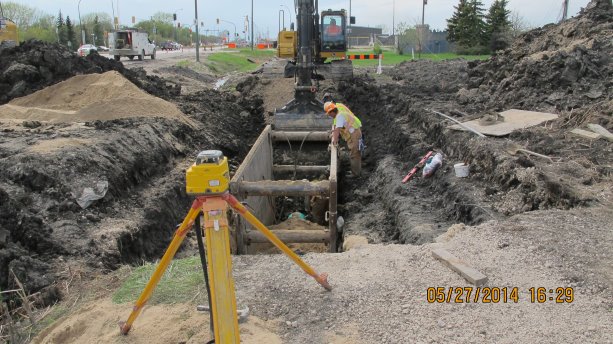A number of issues have made the construction of a $77 million underpass project on a busy Winnipeg roadway a challenging project.
Plessis Road at Dugald Road in the eastern Winnipeg neighbourhood of Transcona has long been a busy intersection.
Up to 20,000 vehicles pass through it daily.
Train delays have been added to the challenges and delays for motorists passing through that intersection.
A little more than two years ago, the three levels of government announced an ambitious plan to eliminate the traffic tie-ups caused by trains by building an underpass, which would separate trains from motor vehicles, bicycles and pedestrians.
The project was intended to make the area safer and more efficient for all modes of transportation.
One major challenge that has slowed progress was reaching agreement with the CN as well as Shell and Imperial Oil, which own the large oil pipes running through the site.
"Before starting work on the underpass itself, we had to build a shoo-fly railway detour," said Brad Sacher, the city’s director of public works.
He noted that relocating the oil pipe lines was an extremely complicated process.
All the oil had to be drained from the pipelines for several kilometres outside of the construction zone.
Then there were the fibre optics and gas lines that also had to be relocated.
"All kinds of utility lines were threaded through the site," Sacher pointed out.
"We usually only see this level of utility lines in downtown areas."
Work on the project got underway in the spring of 2013.
Along the underpass, work includes land drainage system improvements, upgrading Plessis Road from two lanes to four lanes divided through the underpass, with the potential to add two more lanes at a future date.
It also includes the relocation of oil pipelines and utilities, including watermains, sewers, fibre optic cables, gas mains, distribution poles, street lights and electrical lines. A lift station is also part of the plan.
The lift station capacity is designed to minimize the effects of a one in 50 year rainfall event, as well as minor flooding.
It will enable the underpass to remain a viable transportation corridor for emergency vehicles.
To try to ease the plight of drivers, who generally rely on the Plessis Road route, Sacher said that the city made some changes to the high traffic volume Regent Avenue, which crosses Plessis Road just a few blocks north of the soon-to-be new underpass.
Traffic lights were synchronized and the diamond lanes that were reserved for buses were opened to other traffic.
To discourage motorists from speeding down an alternative route cutting through a residential area and by a school, the city installed traffic calming measures such as roundabouts and speed bumps.
Sacher reported that the work was contracted out in three separate tenders.
The first contract – for $2 million – was awarded to Highway Construction to build the embankment for the shoo fly.
Cando Contracting was awarded $6.9 million to build the rail portion.
The bulk of the contract – $35.5 million – was tendered to PCL Constructors Canada to do the major portion of the work.
"Now we are full steam ahead," Sacher said.
"We are just hoping that the weather becomes more co-operative."
The scheduled completion date is Sept. 1, 2015.












Recent Comments
comments for this post are closed